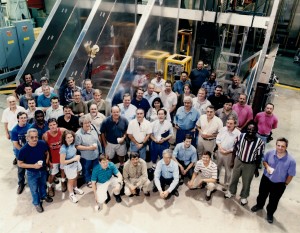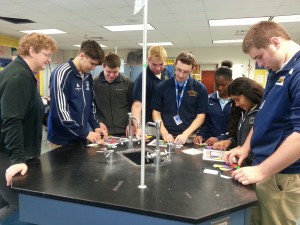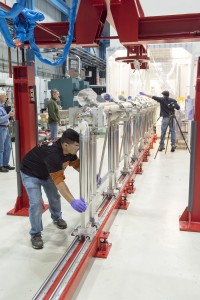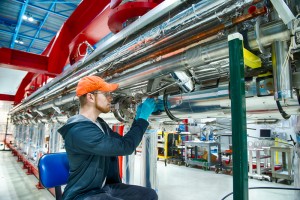
On Aug. 25, 2000, the DZero collaboration team completed construction on the forward muon system detectors. Designing and building the detector took approximately five years with the help of scientists, engineers and technicians from Fermilab, JINR and other Russian institutions. Photo: Fermilab
Near the end of the competitive Space Race in the early 1970s, a Soviet institution joined forces with a young Fermi National Accelerator Laboratory to work toward a greater understanding of the subatomic world. The Joint Institute for Nuclear Research in Dubna, Russia, which celebrated its 60th anniversary on March 26, remains an important, long-running Fermilab collaborator.
This relationship began in 1972 when JINR sent some of the first Soviet scientists to Fermilab. Together, American and Soviet scientists worked at the lab’s first accelerator system, using a Soviet-built jet hydrogen target in the proton beam.
“After this initial collaboration, there were quite a few scientists traveling between the United States and the Soviet Union,” said Dmitri Denisov, co-spokesperson on the DZero experiment and head of Fermilab’s Particle Physics Initiatives Department. “There were many labs in the USSR active in accelerator-based particle physics and using high-energy accelerators that resembled the science at Fermilab.”
Soviet scientists from multiple institutions soon noticed the similarities between the USSR and U.S. experiments as well as interesting, mutual scientific goals. In spite of the tension between the two nations, Fermilab became one of the few places in the U.S. for Soviet scientists testing their prototypes, conducting R&D projects and performing sophisticated, long-term experiments, Denisov said. This collaboration became a symbol of two competing countries overcoming their differences and working together to move the field of particle physics forward.
By the late 1980s and into the 1990s, CDF and DZero became a major focus at Fermilab for Russian particle physicists. At that time, Denisov was a young graduate student and worked with the Institute for High Energy Physics in Protvino, a small city near Moscow. He, along with a few other colleagues, joined the DZero experiment.
“We were all eager to come here, and about one or two years later, we planned to go back and construct a similar, even larger experiment in the USSR,” he said. “But the situation became difficult as the USSR disintegrated in 1991.”
Russian particle physics experimentation slowed down, and many projects ended. One option was to come to Fermilab and keep up with the ongoing experiments here. Although there were very few of them at the time, Russian scientists at Fermilab contributed to the discovery of the top quark. Soon after the discovery, more scientists came to the lab to work with other collaborators, upgrading the DZero detector or joining the CDF experiment.
Experiments at the Tevatron, which was the world’s highest-energy collider in the early 2000s, was the peak of Russian collaboration at Fermilab and provided a great opportunity to plan for future projects with Russia. By about 2005, a total of almost 300 scientists and engineers from Russian laboratories and universities joined Fermilab in several experiments. At the end of the Tevatron run, a couple of years later, many Russian scientists and engineers joined projects such as NOvA and Mu2e.
In early 2014, as the crisis in Ukraine unfolded, U.S. and Russian relations grew fragile, and additional approvals were necessary for Russian users and visiting scientists visiting Fermilab.
Aleksandr Simonenko, a contributing scientist from JINR, used to visit Fermilab for six months out of the year in 2007 for the CDF experiment. Simonenko now visits Fermilab for almost three months out of the year for the Mu2e experiment. Russian institutions continue to send their scientists to Fermilab to work on experiments such as CDF, DZero, Muon g-2, Mu2e and NOvA.
Last year, 75 scientists from 10 collaborating Russian institutions and laboratories worked at Fermilab.
“I think all scientists should participate in collaborations like this one, because each time you come, you get some additional experience and learn about the work of other places,” Simonenko said.
With the proposed international DUNE experiment, Fermilab may be able to further boost Russian participation.
“We must think of our work as science without borders,” Denisov said. “Science doesn’t depend on politics that much, but it’s beneficial to exchange our cultures and views. Science brings us together, and it is the same here just as it is in Russia. That’s why we work well together.”

Students at Riley High School recently attended a QuarkNet masterclass to learn how to analyze data from the CMS experiment at CERN. Photo courtesy of Susan Sakimoto
As organizations and institutions around the United States push for higher standards in science and mathematics education, some communities have to get creative in finding sufficient resources to meet these expectations. One teacher in South Bend, Indiana, reached out for better opportunities for its students.
On March 18, Riley High School juniors and seniors attended a QuarkNet masterclass to discuss some of the research and analysis they conducted during this spring semester. According to a 2015 Indiana Department of Education review, Riley is one of the more diverse schools in the state: Nearly 30 percent of its student population is black, and 20 percent are Hispanic.
During the QuarkNet program, the students received first-hand experience working with data from the CMS experiment at CERN.
“The masterclass helps students understand how we reconstruct data in our detectors and identify the mass of each particle event in the data collected,” said Daniel Karmgard, a Fermilab visiting scientist, QuarkNet mentor and a physics professor at the University of Notre Dame. “Part of what we’re showing them is how to apply concepts they have already learned in the classroom to particle physics.”
The one-day masterclass is meant to provide an engaging way for students to do physics – one that closely resembles how particle physicists do their own research.
“The usual classroom science course can be quite bland because of all the worksheets and normal labs done in high school,” said Ben Dowd, an 18-year-old senior participating in QuarkNet masterclass program. “I really enjoyed listening to our masterclass mentor; he was very educated, and I felt like I learned a lot from him. He explained some of his work on CMS, then during the videoconference, the moderators explained what they did at Fermilab with their research, and it was extremely fascinating.”
In the few weeks leading up to the masterclass, the students were introduced to particle physics, learned how to analyze the data coming from the LHC and then got started on research and analysis. On the day of the masterclass, students from teacher Susan Sakimoto’s class at Riley went to Notre Dame University and attended a videoconference moderated by Fermilab physicists. Students from Zurich, Switzerland, and Catania, Italy, also pooled their results from their CMS data analysis and joined the conversation.
Depending on the results the students obtained, the QuarkNet mentor and moderators can show the students evidence of a Z boson, J/Psi and Upsilon mesons or the Higgs boson.
“My students always enjoy this experience,” Sakimoto said. “They like learning something real and having their own data. It’s also a great link to the Higgs boson news events, since the students find some Higgs boson candidates.”
Erik Bidwell, an 18-year-old senior who attended the masterclass, said he is doing an independent study on Einstein’s theory of relativity this semester.
“I never understood how much the LHC incorporated relativity in their particle physics research,” Bidwell said. “I was already interested in pursuing a job in science, but the masterclass allowed me to expand my knowledge of a future in physics, and the topic interests me more than ever before.”
The QuarkNet masterclass program proved to be an effective way to teach students applicable and collaborative physics. Interested teachers submit requests to a QuarkNet program for their physics students to participate in masterclasses.
Prior to teaching at Riley, Sakimoto was a geophysics assistant professor at Notre Dame and a research scientist at NASA’s Goddard Space Flight Center in Maryland. This is the third year she introduced her Riley students to QuarkNet, and she is delighted by their enthusiasm.
“QuarkNet masterclasses help all of my students stay interested in physics and willing to participate,” she said. “It is particularly welcome in sparking interest in women and minorities, who are traditionally not well-represented in physics.”

Members of the Fermilab Technical Division line up eight superconducting accelerator cavities to form a cavity string destined for SLAC National Accelerator Laboratory’s LCLS-II. Photo: Reidar Hahn
In February, a Fermilab team came together to witness a moment they’d looked forward to for over a year. Crew members parted the plastic sheeting at one end of a cleanroom and rolled out on narrow tracks a long string of eight accelerating cavities. It was the first cavity string for LCLS-II, which will greatly increase the power and capacity of SLAC’s Linac Coherent Light Source.
Accelerating cavities are structures that impart energy to a particle beam, and they’re the heart of the cryomodule — a major accelerator section — that Fermilab has designed and is building for LCLS-II.
“It’s a big deal. The cavity string’s all bolted up — it’s beautiful,” said SLAC scientist Marc Ross, LCLS-II cryogenics systems manager. “It’s a concrete step toward LCLS-II’s realization.”
SLAC’s LCLS-II is a powerful X-ray laser that will allow scientists to glimpse nature’s fundamental processes on an atomic level and ultrafast time scales. Today SLAC announced DOE approval of the start of construction for LCLS-II.
Since the rollout, the Fermilab team has been outfitting the cavity string with cooling equipment, instrumentation and structural support to form the cryomodule. By summer, they will have completed their first one.
“To me this is a major milestone because it shows that we can do it,” said Camille Ginsburg, the cryomodule team lead for the Fermilab LCLS-II effort. “It represents having tested all of those cavities successfully, finalized the design and put together all the assembly infrastructure that was required.”
The cryomodule is destined for LCLS-II’s new superconducting linear accelerator. Electrons speeding down the accelerator will generate an almost continuous X-ray laser beam with pulses of up to a million times per second — thousands of times faster than the current LCLS puts out. To be superconducting, the cryomodule’s cavities, made of niobium, must operate at minus 456 degrees Fahrenheit.
The linear accelerator backbone of LCLS-II comprises 37 cryomodules. Thomas Jefferson National Accelerator Facility in Virginia, another LCLS-II collaborating institution, will build 18 cryomodules of this type. Fermilab is building 17 of these cryomodules plus two that will operate at a higher frequency.

Andrew Penhollow of the Fermilab Technical Division tends to the LCLS-II prototype cavity string, which is seen here mounted to cooling infrastructure. Photo: Reidar Hahn
The boost from a pulsed beam to a continuous one means that the new accelerator will require much more power to operate. And with great power comes the need for great efficiency.
That’s why Fermilab scientists have, for the better part of a decade, been working on methods for building and treating cavities to be as efficient as they can be. By imparting maximum energy to the beam with minimal energy loss, efficient cavities help drive down the cost.
Last year, the Fermilab team reported a world-record quality factor, an indicator of the cavity’s efficiency in minimizing thermal losses.
“The performance of the individually tested cavities that were put into the string was far beyond anything that has been put into such a cryomodule before,” Ross said.
Fermilab also designed the cryomodule’s instrumentation to be able to handle the high power and its plumbing system to carry away heat.
“With continuous-wave operation, there’s a much higher heat load than there is with pulsed-beam acceleration, so everything has to be more robust,” said Fermilab’s Elvin Harms, who leads cryomodule testing for LCLS-II at Fermilab.
Scientists and engineers specially designed the couplers that transfer the radio-frequency power to the cavities with thicker, high-conductivity plating, for example, to carry away the high heat load.
The assembly process to this point has been painstaking, said Fermilab scientist Anna Grassellino, who is responsible for cavity preparation and testing for LCLS-II. And it promises to remain that way until the cryomodule is finally delivered to SLAC.
“Everything that’s happening now with the cryomodule assembly — every step is critical,” Grassellino said. “How you handle the parts can affect performance.”
Technicians who successfully assembled the first cavity string in the cleanroom spent two weeks carefully putting the components together. Following a protocol established at DESY in Germany and Saclay in France and borne out in tests at the Fermilab Accelerator Science and Technology facility, they moved in slow motion, since too-rapid movements would create particulates that could make their way into the cavity, degrading its operation in an accelerator.
“These techniques that seem ancillary are actually quite sophisticated,” Grassellino said. “When the cavity string was finished, it was, ‘Phew! Now it’s sealed, now it rolls out.’”
Crews are carefully installing shielding to protect the cavities from Earth’s magnetic field, which would ruin their performance; welding the cavity string to the plumbing for the super-cooled helium that will keep the cavities cold; and connecting everything structurally inside the vacuum vessel.
Cryomodule tests will begin early this summer. Fermilab and Jefferson Lab plan to move the completed cryomodules to SLAC toward the end of 2016.
“Congratulations to the entire cryomodule team here, at Jefferson Lab and at SLAC,” said Rich Stanek, Fermilab LCLS-II senior team leader. “We’re working hard to deliver cryomodules that meet or exceed specifications within the project cost and schedule.”
LCLS-II, like its predecessor LCLS, will be a DOE Office of Science User Facility.
